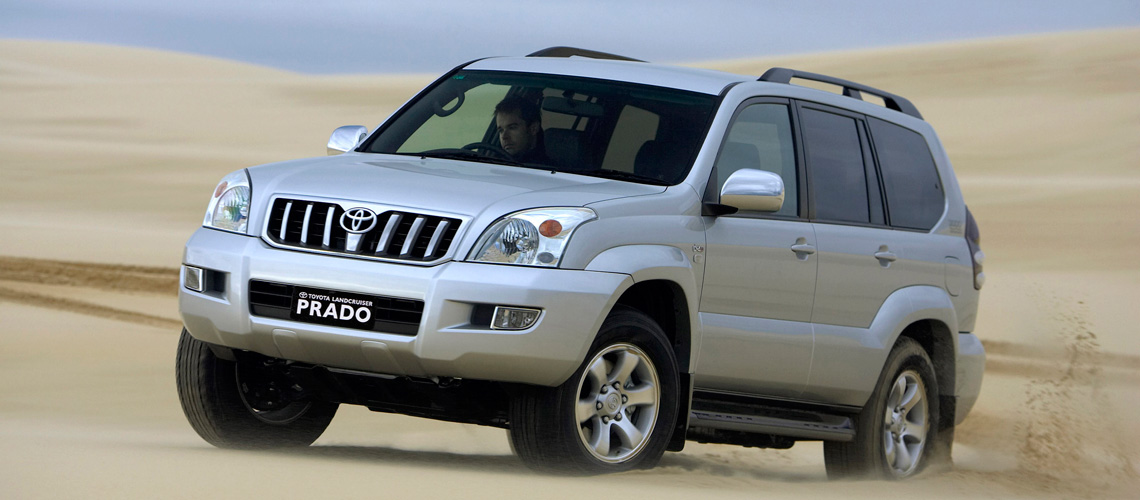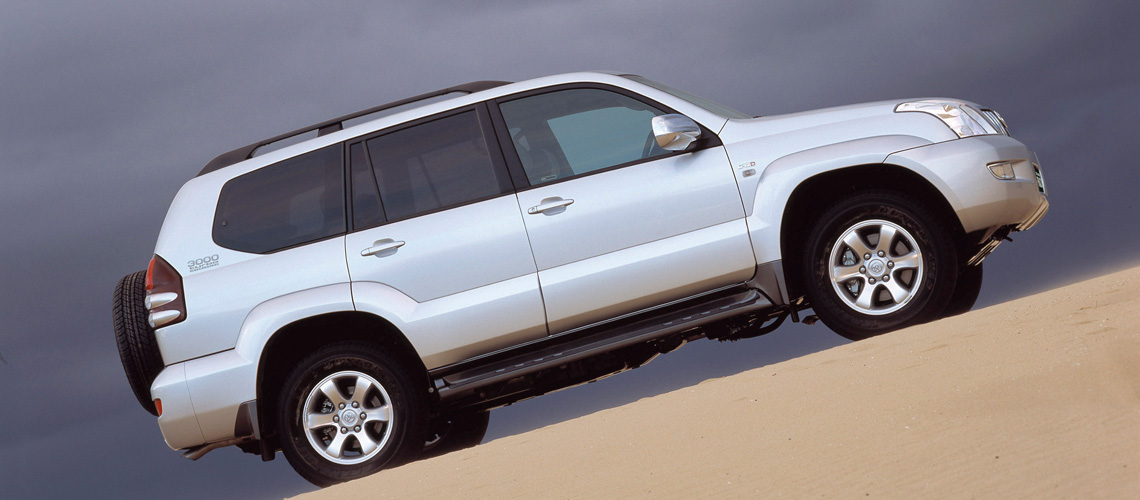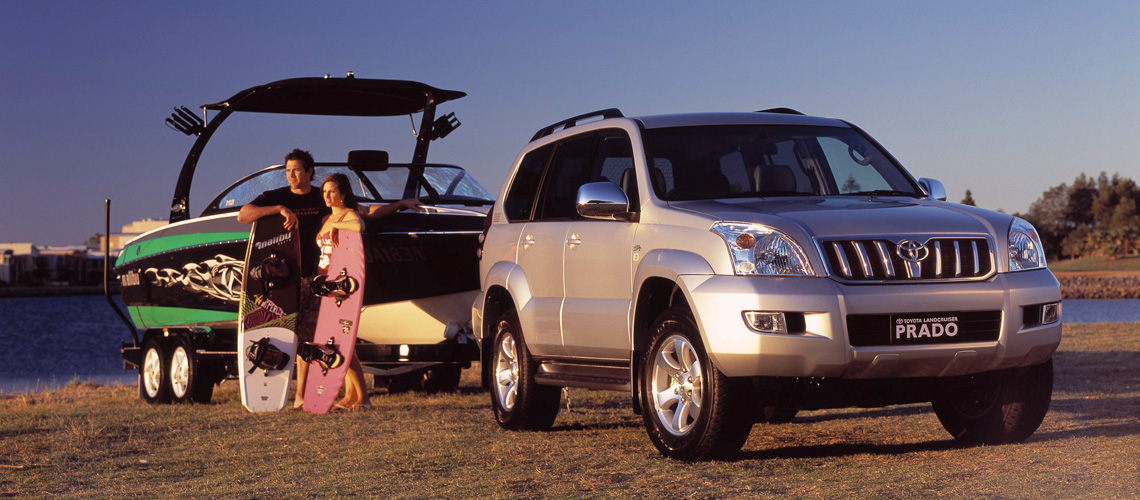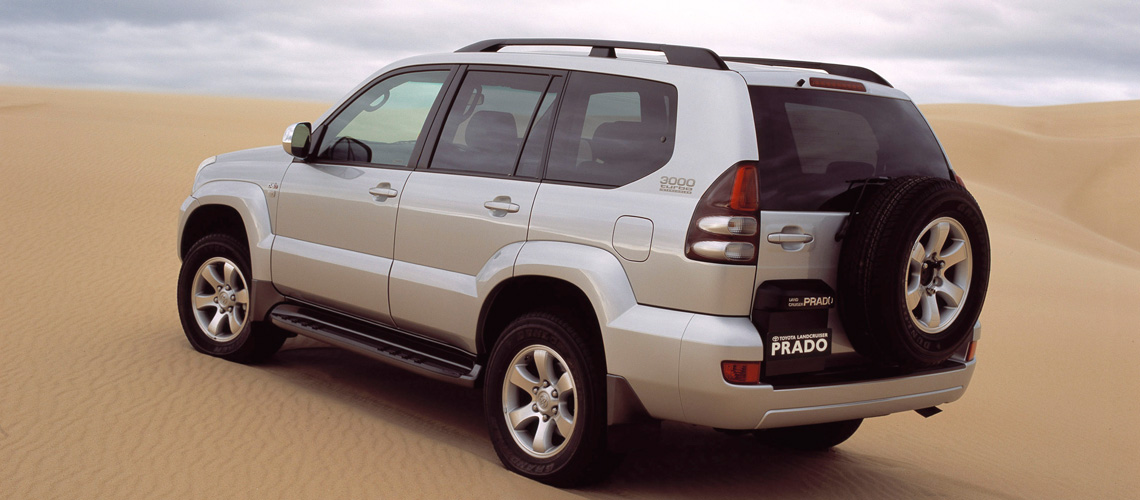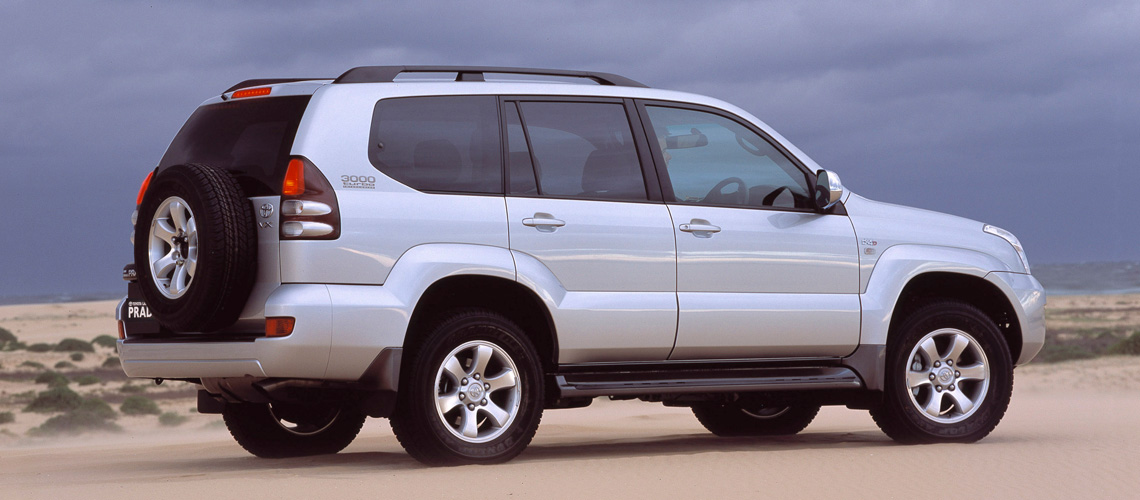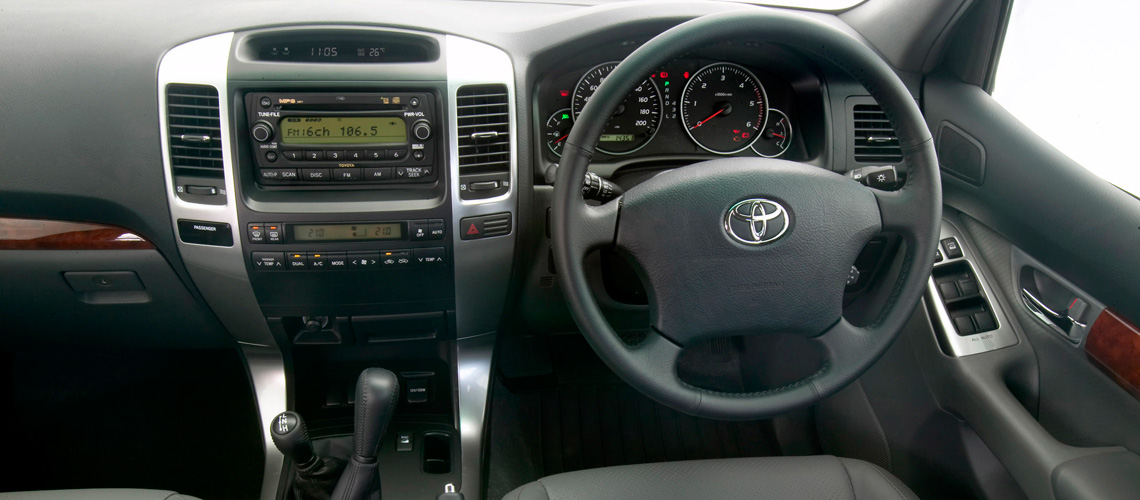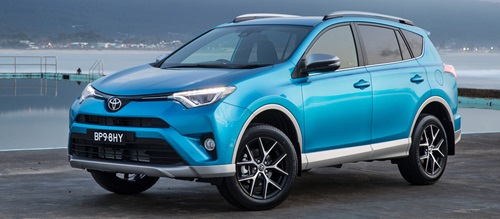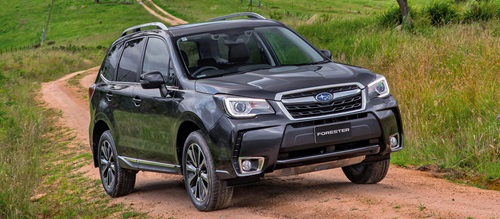Specifications |
|
| Priced from | $44.400 |
| Engine | |
| Transmission | |
| Fuel Economy |
|
| Output | |
| ANCAP rating |
Not Tested |
Toyota's mid size 4WD has been a dominant player in its class for the past decade. The 2007 model features a long overdue upgrade for those who prefer turbo diesel power.
Value for money
Pricing
The base model GX 4.0 V6 petrol is $44,400; the 3.0 turbo diesel is $47,290; GXL costs $54,290/$55,290; VX is $67,290/$68,290; top of the line Grande is $74,290/$75,290.
Warranty
Three years/100,000 kilometres, which is average.
Standard features
The popular GXL includes airconditioning, two front airbags, ABS brakes, an in dash six stack CD, cruise control, remote central locking, power windows/mirrors, roof rails, tinted side glass, 17 inch alloy wheels, lap/sash belts plus head restraints for all eight seats.
VX adds the five speed auto, leather, power front seats, stability control, hill start and descent control, side and curtain airbags, dual auto air and a separate rear cooler. The Grande adds rear air suspension with height control, navigation, a sunroof, cool box, alarm and a trip computer. Options: A five speed automatic costs $3000 on GX and GXL petrol models. It is standard on the VX and Grande. ABS/cruise control/leather wrapped wheel $1250 (GX). Metallic/mica paint $300. 2500 kg towbar approx $265 (plus fitting.)
Retained value
A three year old 3.0 litre turbo diesel GXL auto retains approximately 60 per cent of its new price after three years, which is above average.
Design and function
Ergonomics
The driver faces a clean, stylish dash with Toyota's trademark unbeatable user friendliness and functionality. Fake metal highlights are convincing enough to give the GXL an upmarket feel; outstanding fit and finish quality confirms this impression. The wheel is height adjustable; some reach adjustment would be useful for taller drivers. Vision is clear around the car; the tailgate mounted spare does not overly compromise the rear view, though a rear camera is almost essential if you're going to use the Prado for the school run.
Innovation
The 4.0 litre petrol V6 produces 179 kW at 5200 rpm - more power than the 100 Series Cruiser's 4.7 litre V8 - and 376 Nm of torque at 3800 rpm; a solid 343 Nm is available from 2400 rpm. The new 3.0 litre direct injection turbo diesel produces 127kW at 3400 rpm and 410Nm from 1600-2800rpm.
A TORSEN (torque sensing) centre differential permits constant four wheel drive operation, in high and low range. Toyota uses a low cost, robust, separate steel frame light truck chassis. Double wishbone front/five link solid axle rear suspension is fitted. Brakes feature twin piston front calipers and (on all model bar GX) ABS with emergency full power assist.
A 180 litre fuel tank gives the Prado the legs to go almost anywhere, especially the diesel which has a touring range of more than 1500 km.
The Prado is rated to tow up to 2500 kg.
Safety
The Prado scored four ANCAP stars.
Security
The Prado GXL scored only 47 out of a possible 120 in NRMA Insurance security ratings.
Comfort
The driver's seat, though comfortable, is flat and lightly bolstered. Like most Toyota seats, its padding could be firmer for improved long distance comfort and durability.
Space and practicality
The middle seat has plenty of leg room and a long supportive cushion. Child restraint anchor points are provided on the back of the seat.
The 50/50 split third row seat is suitable for sub-teenage kids only. They crawl in to the back via either side of the tumble forward 60/40 split fold middle seat. There are three seating positions - making the Prado the only eight-seater in this class - but realistically only two kids can fit comfortably. The side windows are hinged, so they can get some air.
The seats are stored against the side windows, where they take up lots of space. However they are easily removed. That done, the cargo area is long and wide, with a low floor for easy loading. Fold the row two seats and you have a 1.5 metre long floor.
The test car's heavy, side hinged tailgate would not stay open on a slight slope. If others are like this, there's a distinct possibility of it swinging shut and jamming someone against the vehicle.
The design itself is clumsy in confined spaces and less durable than a roof hinged or horizontally split door.
Build and finish quality
Excellent in all respects.
On the road
Fuel efficiency
The owner's handbook recommends premium unleaded for peak performance from the 4.0 V6 petrol.
Fuel consumption - usually the bane of petrol powered four wheel drives - is excellent given the Prado's engine capacity and weight. You can get down into the 11 litres/100 km region on the highway, while in town you'll do 14-16 litres/100 km. These figures are comparable with a Falcon.
As far as the new 3.0 turbo diesel is concerned, it's also a miser. Toyota claims economy gains of 20-26 per cent over the old engine, with a combined Australian standard test average of 9.2-9.3 litres/100 km.
We achieved 10.7 litres/100 km in the automatic on a quick 165 km run through some quite hilly country. You could certainly return single figures on an easy highway cruise; around town, expect 12-14 litres/100 km.
Performance
The 4.0 litre V6 shifts the 2.11 tonne Prado effortlessly, with a strong, linear delivery from idle to redline and class leading refinement.
Off-road in low range, copious bottom end grunt walks the Prado up steep, rocky slopes without strain.
It drives the Prado from zero-100 km/h in ten seconds flat, which is pretty quick.
The new 3.0 turbo diesel is much more powerful and refined than the old 96kW engine. It delivers easy, smooth pulling power across a wide rev range, and cruises beautifully, in silence.
There's some transient vibration under acceleration, like all four cylinder diesel engines.
Serious torque arrives a couple of hundred revs above idle. It doesn't quite have the emphatic midrange of some European 3.0 litre engines, but this progressive delivery means that its performance is deceptively strong.
It's a stretch to the stubby low range lever. The mechanical centre differential can be open or locked in high range, and is automatically locked in low. It splits the torque 40/60 front rear in normal conditions.
Ride
Ride comfort is luxurious. Big, baggy tyres, long travel suspension and lots of rubber between the chassis and the body ensures that rough surfaces are felt only as a gentle tremor.
Handling and steering
The Prado is a 4WD from the old school - a tall, heavy wagon, built on a separate light truck chassis, with primitive suspension and ordinary tyres.
So it's rather cumbersome in town, while its open road dynamic limits are inevitably low compared with, lighter, lower, unitary construction/independently suspended SUVs like the Kluger and Ford Territory. The Pajero is also a better handler.
The softly sprung live axle rear suspension can skip sideways occasionally on corrugations. In very rough off-road territory, longer travel at both ends is an asset, though the damping is too light.
Braking
The brakes are adequate but more initial bite would not go astray. Some fade was evident on a long downhill run.
Smoothness and quietness
No problems here. The Prado is a very refined wagon, despite its old school chassis engineering.
Summary
As a purely city-based wagon, the Prado is overkill. You're better off in a Kluger or Ford Territory. However, if you like to get off the beaten track, where the Prado's ability is excellent, and/or need a serious towing vehicle, the Prado will do the job well. The new turbo diesel engine is a beauty.







